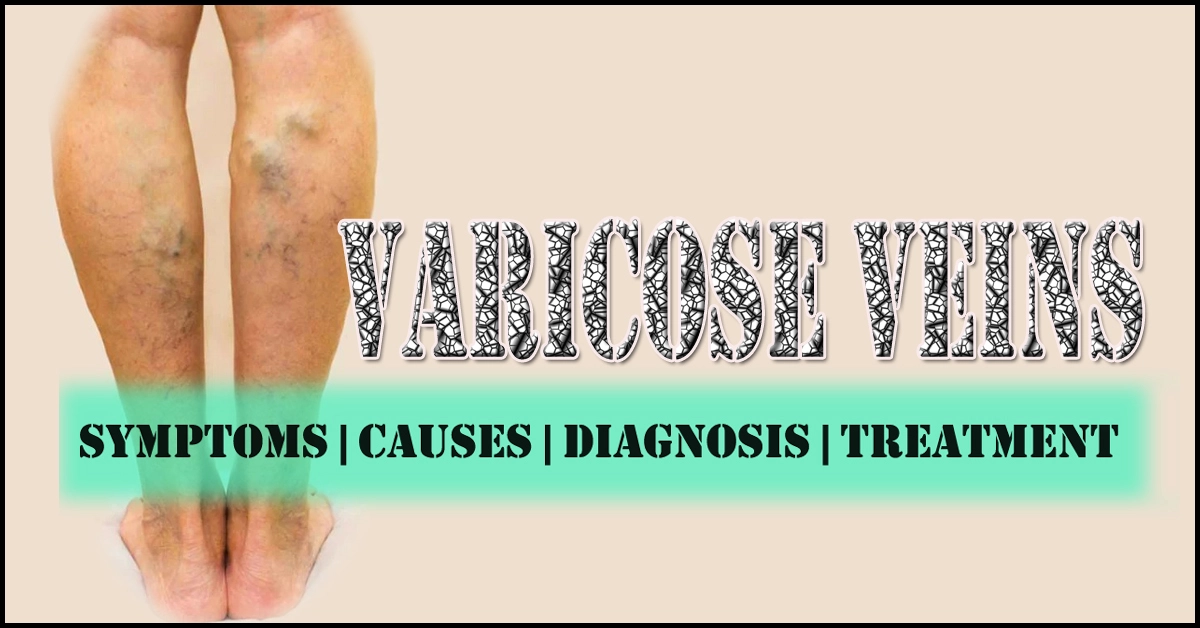
Varicose veins: Causes, Diagnosis & Treatment
Varicose veins: Large, twisted veins known as varicose veins typically develop on the legs. Which are also called spider veins. They are caused by weakened or damaged valves in the veins, which can lead to blood pooling in the veins and causing them to bulge. Varicose veins can be blue, red, or flesh-colored, and may be painful or cause aching, throbbing, or cramping in the legs.
Factors that can contribute to the development of spider veins include age, family history, pregnancy, obesity, prolonged sitting or standing, and a sedentary lifestyle. While they are not usually a serious medical problem, varicose veins can be uncomfortable and unsightly.
Treatment options for varicose veins may include lifestyle changes, such as exercise and weight loss, compression stockings, and minimally invasive procedures such as sclerotherapy or Endovenous laser treatment. In more serious cases, surgery can be necessary. If you have spider veins, it’s crucial to speak with your healthcare practitioner since they can advise you on the best course of action for your particular condition.
How many types is it
Varicose veins can be categorized into two types based on the size and location of the affected veins:
- Primary varicose veins: These are the most common type of varicose veins and occur in the superficial veins just beneath the skin. They often affect the veins in the legs and can be caused by weak or damaged valves that allow blood to flow backward and pool in the veins.
- Secondary varicose veins: These occur as a result of a blockage or obstruction in the deep veins, which causes blood to flow through alternative pathways in the superficial veins. This can result from conditions such as deep vein thrombosis (DVT), tumors, or injury.
It’s important to note that varicose veins can vary in severity and may be classified based on the diameter of the affected veins, the severity of symptoms, and the presence of complications. Your healthcare provider can provide a more detailed classification based on your individual situation.
Symptoms
Varicose veins may not cause any symptoms in some people, but others may experience the following:
- Swelling in the legs: Varicose veins can cause fluid to build up in the legs, leading to swelling and discomfort.
- Aching or throbbing in the legs: The enlarged veins can put pressure on surrounding tissues, causing pain and discomfort.
- Itching or burning in the affected area: The skin around the affected veins may become dry, itchy, or irritated.
- Muscle cramping, particularly at night: The affected leg muscles may cramp or spasm, particularly at night.
- Heavy feeling in the legs: The legs may feel heavy or fatigued, particularly after prolonged periods of standing or sitting.
- Skin discoloration or ulcers near the ankle: In severe cases, varicose veins can cause skin discoloration or even open sores near the ankle.
If you have varicose vein problems, it’s crucial to speak with your doctor since they can diagnose you and suggest the most appropriate course of action.
Causes
Here are some additional details on the causes of varicose veins:
The primary cause of varicose veins is weakened or damaged valves in the veins that prevent proper blood flow. Normally, the valves in the veins keep blood flowing toward the heart. Blood can flow backward and pool in the veins, expanding and twisting them when these valves are weak or broken.
Varicose veins can develop as a result of several circumstances, including:
- Age: As you age, your veins can lose elasticity, making them more prone to damage and less able to efficiently move blood through the body.
- Genetics: Varicose veins may run in families, suggesting that there may be a genetic component to their development.
- Pregnancy: The increased pressure on the veins in the pelvis and legs during pregnancy can lead to the development of spider veins.
- Obesity: Excess weight can put pressure on the veins in the legs, leading to the development of varicose veins.
- Prolonged standing or sitting: Jobs or activities that require prolonged periods of standing or sitting can increase the risk of varicose veins.
- Hormonal changes: Spider veins are more likely to develop in people who experience hormonal changes, such as those that take place during puberty, pregnancy, or menopause.
- Injury or trauma to the affected area: Injury or trauma to the legs can damage the veins and increase the risk of spider veins.
It’s important to note that while these factors can increase the risk of varicose veins, they don’t always cause them. Some people with no known risk factors may still develop varicose veins. If you have concerns about your risk of developing spider veins, talk to your healthcare provider. They can provide guidance on prevention strategies and recommend the best course of treatment if you develop varicose veins.
Risk factors
Here are some additional details on the risk factors for varicose veins:
- Age: The risk of developing spider veins increases with age. As the veins lose elasticity and become more prone to damage over time.
- Gender: Women are more likely to develop spider veins than men, possibly due to hormonal changes that affect vein health.
- Family history: If you have a family history of spider veins, you may be more likely to develop them yourself.
- Pregnancy: The increased pressure on the veins in the pelvis and legs during pregnancy can increase the risk of varicose veins.
- Obesity: Excess weight can put pressure on the veins in the legs, increasing the risk of spider veins.
- Sedentary lifestyle: Lack of exercise can contribute to poor circulation and increase the risk of spider veins.
- Smoking: Smoking can damage blood vessels and reduce circulation, increasing the risk of varicose veins.
- Standing or sitting for long periods: Jobs or activities that require prolonged periods of standing or sitting can increase the risk of spider veins.
It’s important to note that while these factors can increase the risk of spider veins, they don’t always cause them. Some people with no known risk factors may still develop spider veins. If you have concerns about your risk of developing varicose veins, talk to your healthcare provider. They can provide guidance on prevention strategies and recommend the best course of treatment if you develop spider veins.
Diagnosis
Here are some Additional details on the Diagnosis of Varicose veins:
- Physical Examination: A Healthcare Provider will Typically perform a physical Examination of the affected area, looking for signs of Enlarged, twisted veins.
- Ultrasound: An Ultrasound can help confirm a Diagnosis of Varicose veins by showing the blood flow in the affected veins.
- Venogram: A Venogram is a type of X-ray that uses a special dye to Highlight the veins. Allowing a Healthcare Provider to see any Abnormalities in the blood flow.
- CT scan or MRI: These imaging tests can be used to provide a more Detailed view of the veins and the Surrounding tissues.
It’s important to talk to your Healthcare Provider if you have symptoms of spider veins or are concerned about your risk of Developing them. They can provide a Diagnosis and recommend the best course of treatment for your individual situation.
Also Read – The Neck: Anatomy & Surgery
Treatment of Varicose veins
Here are some additional details on the treatment of varicose veins:
- Compression stockings: Wearing compression stockings can help improve blood flow and reduce the symptoms of spider veins.
- Lifestyle changes: Making changes to your diet and exercise habits. As well as taking breaks to stretch and move throughout the day, can help improve circulation and reduce the risk of varicose veins.
- Sclerotherapy: This involves injecting a solution into the affected veins, causing them to collapse and be reabsorbed by the body.
- Endo venous laser therapy (EVLT): This involves using a laser to heat and seal the affected veins, redirecting blood flow to healthier veins.
- Radiofrequency ablation: This involves using a catheter to deliver radiofrequency energy to the affected veins, causing them to collapse and be reabsorbed by the body.
- Surgery: In severe cases, surgery may be necessary to remove or tie off the affected veins.
The best course of treatment for varicose veins will depend on the severity of the condition and other individual factors. Such as age, overall health, and medical history. It’s important to talk to your healthcare provider to discuss your options and determine the best treatment plan for your individual situation.
Prevention of Varicose veins
Here are some additional details on the prevention of varicose veins:
- Exercise regularly: Regular exercise can help improve Circulation and reduce the risk of Varicose veins. Walking, cycling, swimming, and other Low-impact activities are all good choices.
- Maintain a healthy weight: Excess weight can put pressure on the veins in the legs, Increasing the risk of spider veins. Eating a healthy diet and Maintaining a healthy weight can help reduce this risk.
- Wear Compression Stockings: Compression Stockings can help improve Circulation and reduce the risk of spider veins. Especially if you have a job that requires Prolonged periods of standing or sitting.
- Take breaks to stretch and move: If you have a job that requires Prolonged periods of standing or sitting. Taking breaks to stretch and move can help improve Circulation and reduce the risk of Varicose veins.
- Elevate your legs: Elevating your legs above the level of your heart can help improve Circulation and reduce the risk of spider veins.
- Avoid tight clothing: Wearing Restrictive clothes increases the risk of spider veins and Restricts blood flow. Avoid wearing Tight-fitting clothes, especially around the waist, legs, and groin.
- Quit smoking: Smoking can damage blood vessels and reduce Circulation, Increasing the risk of spider veins.
While these prevention tips may not guarantee that you won’t develop spider veins. They can help reduce your risk and improve your overall vein health. If you have concerns about your risk of developing spider veins, talk to your healthcare provider. They can provide guidance on prevention strategies and recommend the best course of treatment if you develop varicose veins.
When to see a healthcare provider for Varicose veins
It’s a good idea to see a healthcare provider if you experience any of the following symptoms or risk factors:
- Pain or discomfort in your legs, especially after prolonged periods of standing or sitting.
- Visible veins that are swollen, twisted, or discolored.
- Itchy, burning, or throbbing sensations in your legs.
- Leg cramps or muscle fatigue.
- Swelling in your ankles or feet.
- Family history of varicose veins.
- Pregnancy or recent weight gain.
If you experience any of these symptoms or risk factors, it’s important to talk to your healthcare provider. They can do a physical examination and, if more testing is required, suggest it. Early diagnosis and treatment can help prevent complications and improve your overall vein health.
Disclaimer: The information on this website is provided for Informational reasons and is not meant to be personal medical advice. You should consult your doctor or another Qualified fitness professional if you have any concerns about a Systemic condition. Never Disregard professional medical advice or give up looking for it because of something you read on this website. The Daddydontblog.com does not promote or recommend any products.






Wow, marvelous blog format! How long have you ever been running a blog for?
you made running a blog glance easy. The overall glance of your website is magnificent, as neatly as the content!
You can see similar here sklep internetowy
Someone essentially lend a hand to make seriously articles I would state. That is the first time I frequented your web page and thus far? I surprised with the research you made to make this particular post amazing. Magnificent job!